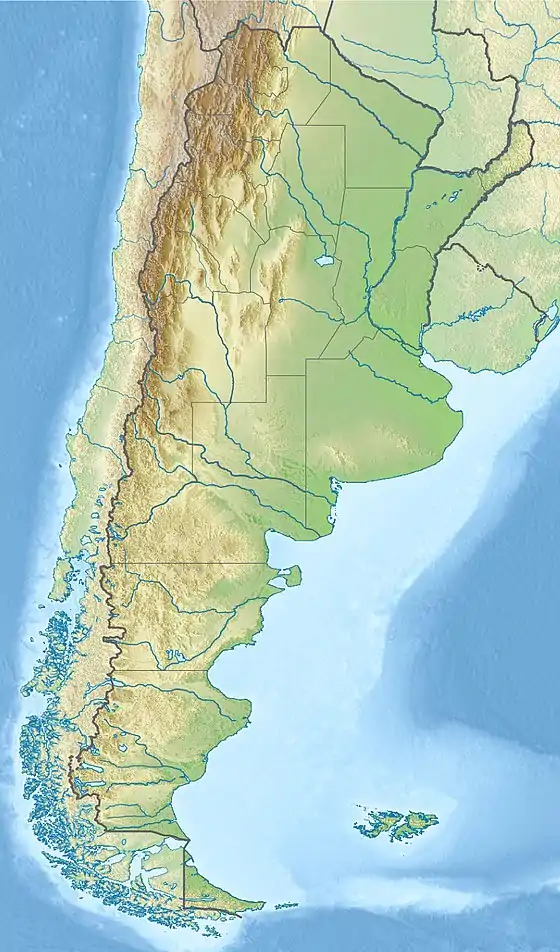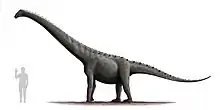| Río Neuquén Subgroup | |
|---|---|
| Stratigraphic range: Late Turonian-Late Coniacian ~ | |
| Type | Subgroup |
| Unit of | Neuquén Group |
| Sub-units | Plottier, Sierra Barrosa, Los Bastos & Portezuelo Formations |
| Underlies | Río Colorado Subgroup |
| Overlies | Río Limay Subgroup |
| Thickness | Up to 155 m (509 ft) |
| Lithology | |
| Primary | Sandstone |
| Other | Claystone, limestone, mudstone |
| Location | |
| Coordinates | 37°24′S 69°06′W / 37.4°S 69.1°W |
| Approximate paleocoordinates | 42°12′S 49°24′W / 42.2°S 49.4°W |
| Region | Mendoza, Río Negro & Neuquén Provinces |
| Country | |
| Extent | Neuquén Basin |
| Type section | |
| Named for | Neuquén River |
 Río Neuquén Subgroup (Argentina) | |
The Río Neuquén Subgroup is a geological subgroup in the Neuquén Basin, Neuquén Province, Argentina, whose strata date back to the Late Cretaceous. The subgroup, formerly defined as a formation, is the middle unit of the Neuquén Group and contains the Plottier, Sierra Barrosa Formation,[1] Los Bastos Formation,[2] and Portezuelo Formations.[3][4][5] The subgroup overlies the Río Limay Subgroup and is overlain by the Río Colorado Subgroup.[6] Dinosaur remains are among the fossils that have been recovered from the formation.[7]
Fossil content
| Dinosaurs | ||||||
|---|---|---|---|---|---|---|
| Genus | Species | Location | Stratigraphic position | Material | Notes | Images |
| Antarctosaurus[8] | A. giganteus[8] | "[Two] femora, pubis."[9] | Río Neuquén remains previously referred to A. giganteus are now attributed to an indeterminate sauropod.[8] | |||
| A. wichmannianus[8] | ||||||
| Megaraptor[8] | M. namunhuaiquii[8] | "Partial forelimb, manus, and pes."[10] | ||||
| Patagonykus[8] | P. puertai[8] | "Partial postcranial skeleton."[11] | ||||
| Rinconsaurus[8] | R. cadamirus[8] |  | ||||
| Titanosaurus[8] | Indeterminate[8] | Titanosaurus is now considered a nomen dubium. | ||||
| Unenlagia[8] | U. comahuensis[8] | "Fragmentary postcrania."[12] |  | |||
See also
References
- ↑ Garrido, 2011, p.237
- ↑ Garrido, 2011, p.236
- ↑ Balgord & Carapa, 2014, p.6
- ↑ Balgord, 2017, p.455
- ↑ Lebinson et al., 2018, p.252
- ↑ Leanza et al., 2004, p.63
- ↑ Weishampel, 2004, pp. 600-604
- 1 2 3 4 5 6 7 8 9 10 11 12 13 14 "Río Neuquén Formation." Weishampel, et al. (2004). Pg. 603.
- ↑ "Table 13.1," in Weishampel, et al. (2004). Page 270.
- ↑ "Table 10.1," in Weishampel, et al. (2004). Page 199.
- ↑ "Table 11.1," in Weishampel, et al. (2004). Page 211.
- ↑ "Table 10.1," in Weishampel, et al. (2004). Page 198.
Bibliography
- Balgord, Elizabeth A. 2017. Triassic to Neogene evolution of the south-central Andean arc determined by detrital zircon U-Pb and Hf analysis of Neuquén Basin strata, central Argentina (34°S–40°S). Lithosphere 9. 453–462. .
- Balgord, Elizabeth A., and Barbara Carapa. 2014. Basin evolution of Upper Cretaceous–Lower Cenozoic strata in the Malargüe fold-and-thrust belt: northern Neuquen Basin, Argentina. Basin Research _. 1–24. Accessed 2019-02-22.
- Garrido, Alberto C. 2011. El Grupo Neuquén (Cretácico Tardío) en la Cuenca Neuquina, 231–244. XVIII Congreso Geológico Argentino. Accessed 2019-02-23.
- Leanza, H.A.; S. Apesteguia; F.E. Novas, and M.S. De la Fuente. 2004. Cretaceous terrestrial beds from the Neuquén Basin (Argentina) and their tetrapod assemblages. Cretaceous Research 25. 61-87. Accessed 2019-02-16.
- Lebinson, Fernando; Martín Turienzo; Natalia Sánchez; Vanesa Araujo; María Celeste D'Annunzio, and Luis Dimieri. 2018. The structure of the northern Agrio fold and thrust belt (37°30’ S), Neuquén Basin, Argentina. Andean Geology 45. 249–273. Accessed 2019-02-22.
- Weishampel, David B.; Peter Dodson, and Halszka (eds.) Osmólska. 2004. The Dinosauria, 2nd edition, 1–880. Berkeley: University of California Press. Accessed 2019-02-21.ISBN 0-520-24209-2
This article is issued from Wikipedia. The text is licensed under Creative Commons - Attribution - Sharealike. Additional terms may apply for the media files.